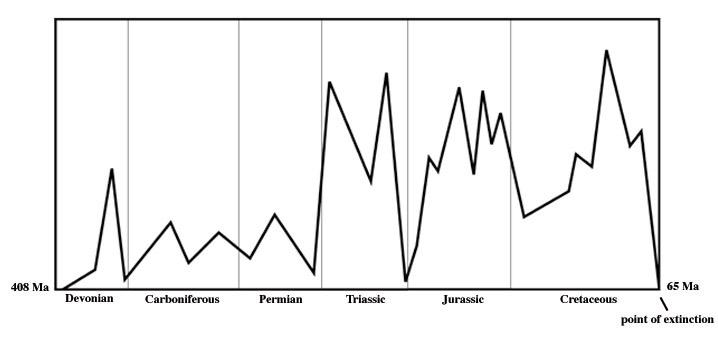(Devonian-Cretaceous)
The ammonoids came close to extinction several times over their evolutionary history. As shown in the graph below , ammonoid abundance was influenced by many factors including climatic change, tectonic activity, changes in sea level, competition, predation, and comet-induced destruction. As the ammonoids evolved the suture patterns noted on their shells became increasingly complex.
Among the specimens displayed at the museum are the Devonian Ternoceras uniangulare (Devonian case); Triassic Beyrichites deleeni (Triassic case). The Jurassic is well represented by the genus Dactylioceras (Dactylioceras commune, Dactylioceras sp., Dactylioceras sp., Dactyloceras sp., and Dactyloceras sp.) as well as specimens of Acantnopleuroceras valdani (Jurassic case) and Praeparkinsonia garantiformis (Jurassic case). The Cretaceous is similarly well represented by specimens of the genus Placenticeras (Placenticeras meeki, Placenticeras intercalare, Placenticeras intercalare, and Placenticeras whitfieldi) as well as Scaphites nodosus (Cretaceous case).

For most living organisms, if the environment changes drastically or even slightly, there is going to be adverse effects in how those organisms interact within their habitat. The ammonoid, for the reasons noted, underwent these trials of change and made remarkable comebacks each time there was near abolishment up until the Cretaceous-Tertiary boundary. At this time the ammonoid finally disappears from the fossil record. However there was the continuance of its predecessor and competitor, the nautiloid. The survival of the nautiloid and disappearance of the ammonite has long puzzled scientists and left many unanswered questions as to why the ammonite could not persevere. A popular possible explanation is based on the differences in morphology between these two similar cephalopods in conjunction with differences such as placement of the siphuncle (the tubing which allowed flow of water and air pressure within the chambered shell).
Ammonoid/Nautaloid Comparative Morphology ® Ammonite Suture Patterns
